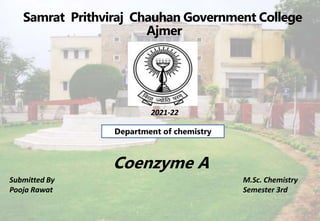
Coenzyme A
- 1. Samrat Prithviraj Chauhan Government College Ajmer 2021-22 Coenzyme A Submitted By Pooja Rawat M.Sc. Chemistry Semester 3rd Department of chemistry
- 2. TABLE OFCONTENT Discovery of Coenzyme A Introduction Structure of Coenzyme A Biosynthesis of Coenzyme A Commercial production Function of Coenzyme A
- 3. DISCOVERYOF COENZYMEA DISCOVERY OF COENZYME A Coenzyme A was identified by Fritz Lipmann in 1946, who also later gave it its name. Lipmann initially intended to study acetyl transfer in animals, and from these experiments he noticed a unique factor that was not present in enzyme extracts but was evident in all organs of the animals. He was able to isolate and purify the factor from pig liver and discovered that its function was related to a coenzyme that was active in choline acetylation The coenzyme was named coenzyme A to stand for "activation of acetate". In 1953, Fritz Lipmann won the Nobel Prize in Physiology or Medicine "for his discovery of co-enzyme A and its importance for intermediary metabolism". Fritz Albert Lipmann (1899-1986)
- 4. INTRODUCTION Coenzyme A (CoA, SHCoA, CoASH) is a coenzyme, notable for its role in the synthesis and oxidation of fatty acids and the oxidation of pyruvate in the citric acid cycle .All genomes sequenced to date encode enzymes that use coenzyme A as a substrate, and around 4% of cellular enzymes use it as a substrate. It is a part of enzyme which consist biological acylation. It helps in transferring the acyl group form the compound to another.
- 5. STUCTUREOF COENZYMEA On enzymatic hydrolysis Coenzyme A gives pantothenic acid, adenosine phosphate and an unidentified sulphur containing product. Further, it was observed that one molecule of adenosine and three molecule of phosphate were produced for each mole of pantothenic acid. Out of three molecules of phosphates one was found to be present as monophosphate and the other two as pyrophosphate ester grouping. The monophosphate ester was found to be present 3'-position of ribose sugar. The pyrophosphate group is present as a bridge between the 5'-position and 4'- position of adenosine and pantothenic acid respectively.
- 6. Structure of coenzyme A: 1: 3′-phosphoadenosine. 2: diphosphate, organophosphate anhydride. 3: Pantoic acid 4: β-alanine. 5: cysteamine.
- 7. BIOSYNTHESISOF COENZYME A In biosynthesis of Coenzyme A requires cysteine, pantothenate (vitamin B5) and adenosine tri phosphate (ATP). Pantothenate is found in food such as meat, vegetables, cereal grains, legumes, eggs and milk. In humans and most living organism pantothenate is an essential vitamin that has a variety of functions. In all living organism Coenzyme A is synthesized in five step process that requires for molecule of adenosine tri phosphate(ATP) and cysteine.
- 8. the biosynthetic pathway of CoA synthesis from pantothenic acid
- 9. COMMERCIAL PRODUCTION Coenzyme A is produced commercially via extraction from yeast, however this is an inefficient process (yields approximately 25 mg/kg) resulting in an expensive product. Various ways of producing CoA synthetically, or semi-synthetically have been investigated although none are currently operating at an industrial scale.
- 10. FUNCTIONOF COENZYMEA Fatty acid synthesis-coenzyme A is, in chemical terms, a thiol, it can react with carboxylic acids to form thioesters, thus functioning as an acyl group carrier. It assists in transferring fatty acids from the cytoplasm to mitochondria. A molecule of coenzyme A carrying an acyl group is also referred to as acyl-CoA . When it is not attached to an acyl group, it is usually referred to as 'CoASH' or 'HSCoA'. This process facilitates the production of fatty acids in cells, which are essential in cell membrane structure.
- 11. Energy production-Coenzyme A is one of five crucial coenzymes that are necessary in the reaction mechanism of the citric acid cycle. Its acetyl-coenzyme A form is the primary input in the citric acid cycle and is obtained from glycolysis, amino acid metabolism, and fatty acid beta oxidation. This process is the body's primary catabolic pathway and is essential in breaking down the building blocks of the cell such as carbohydrates, amino acids, and lipids. Regulation-When there is excess glucose, coenzyme A is used in the cytosol for synthesis of fatty acids. This process is implemented by regulation of acetyl-CoA carboxylase, which catalyses the committed step in fatty acid synthesis. During cell starvation, coenzyme A is synthesized and transports fatty acids in the cytosol to the mitochondria. Here, acetyl-CoA is generated for oxidation and energy production. In the citric acid cycle, coenzyme A works as an allosteric regulator in the stimulation of the enzyme pyruvate dehydrogenase.
- 12. Some of the sources that CoA comes from and uses in the cell.
- 13. Reference Principle of Biochemistry, A.L.Lehninger, Worth Pulishers. Bioorganic, Bioinorganic and Supramolecular Chemistry PS KALSI, J.P.KALSI.
- 14. THANKS YOU